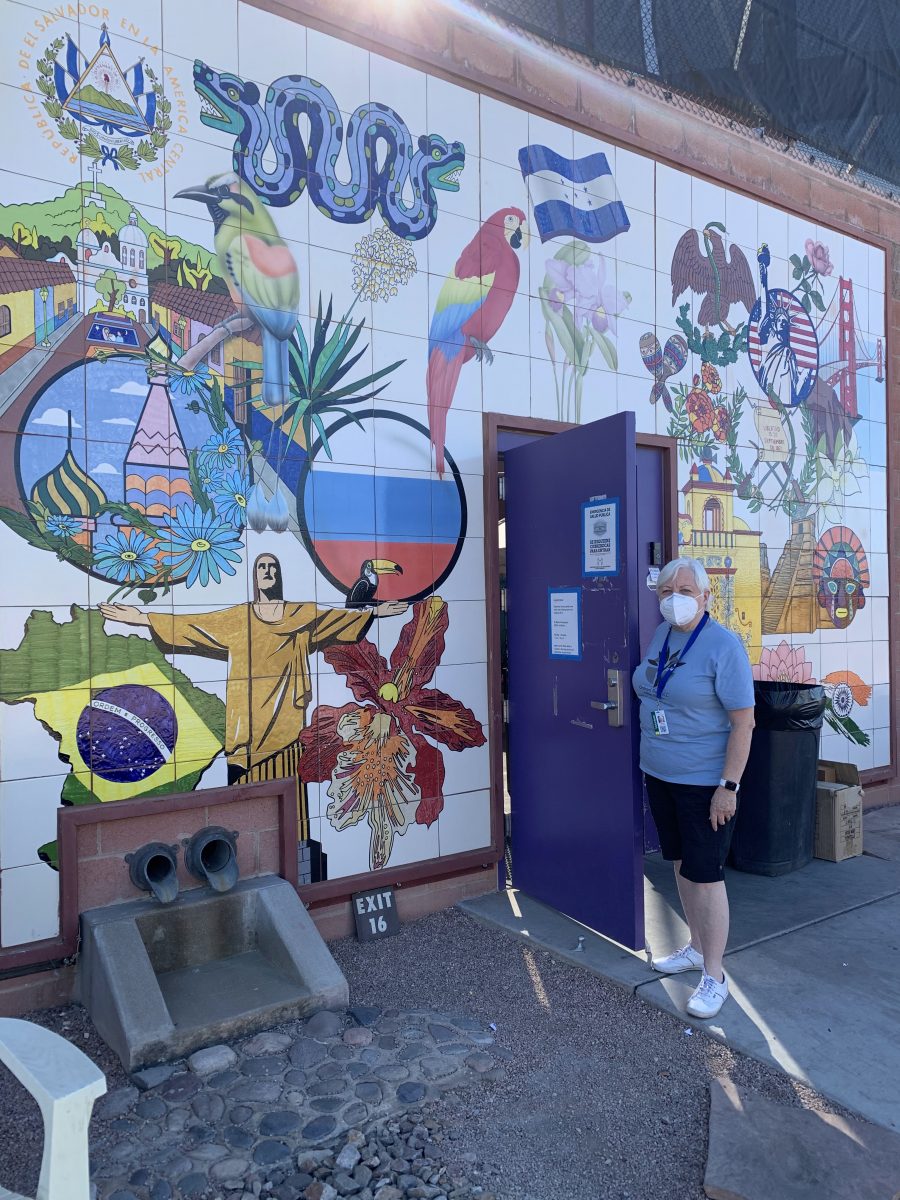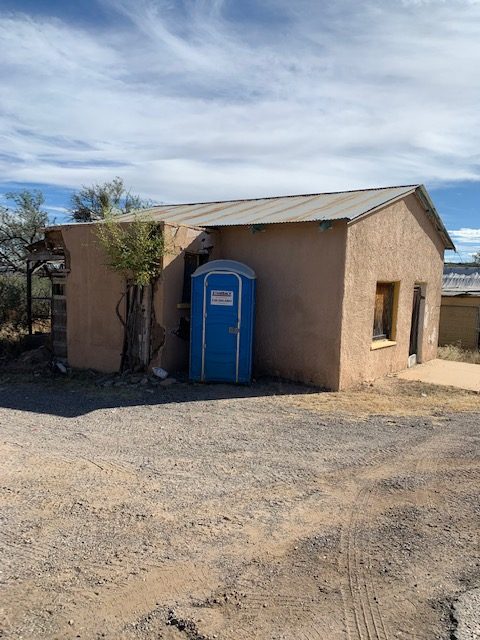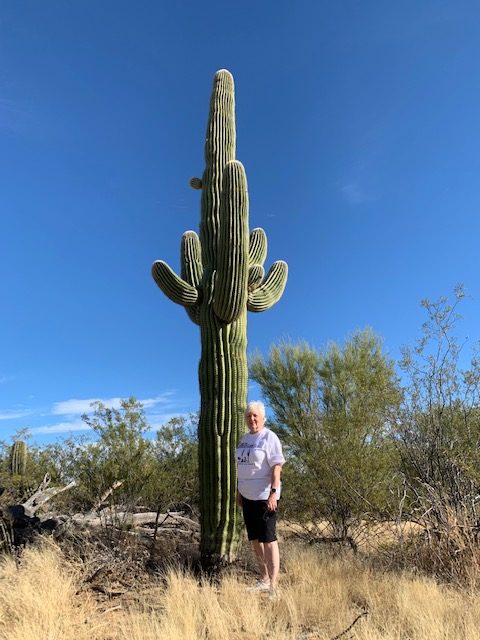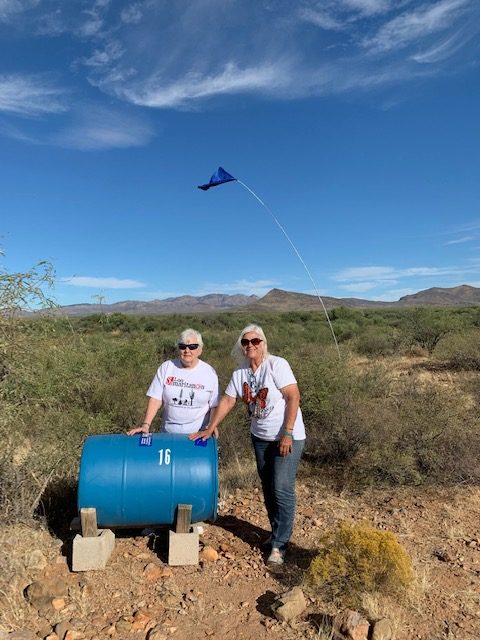Greetings from Casa Alitas #3

Hello from Casa Alitas and Tucson (fast becoming my favorite city)! It’s been a very full and rewarding week, and now that I’ve settled into what might be called a routine, it’s time to come home. I will have been here a month as of Wednesday, November 17 and I admit to a longing to see friends and family (in person), walking in the arboretum, and sleeping in my own bed. The week+ has been filled with many hours at talking with folks at Casa Alitas, visits to a number of new places and some old favorites, with some wonderful dinners and a trip to wine country thrown in the mix.
The number of people arriving at Casa Alitas in the last two weeks has exploded, meaning that 100-125 people arriving per day is now the norm. No one that I’ve talked with has an explanation of why the increase and I’ve decided that this fits into the description of so many things that happen on the border. There’s a randomness to almost everything. Especially notable are things that dramatically effect the future of the lives of a person or family. For example, there are certain border patrol, ICE officers, and judges whose names are recognized for their mistreatment and “questionable” decisions. There are others for whom what they do on a daily basis is just doing their job, shuffling people through lines and filling out forms.
As you know, the people we see at Casa Alitas are those who have been on the receiving end of so many seemingly random decisions of so many. We are there to welcome them. They are so relieved at seeing a welcome face and hearing kind words. As I talk with them, it’s apparent that they are not aware of the challenges that await them as they take their next steps in the broken immigration process of the United States. For me, it’s a joy to share these moments of gratitude with them, providing food and clothing, and sometimes a bit of a geography lesson as they figure out where in the United States (other than Miami) their sponsor actually lives. I assure you that no one knows where Wisconsin is (near Chicago?) and the first time they may have seen the name is on my T-shirt.

The majority of singles that arrive at Casa Alitas continue to be from Cuba and Venezuela. Some of them appear to be well-heeled, as evidenced by how they are dressed and the fact that they arrived via flights from Mexico City, Caracas, or Cancun. I don’t mean to imply that they didn’t save for years to afford these flights. However, their transport here stands in sharp contrast to those who have arrived via caravan, long hauls via van, or walking in the desert.
Going rate for a person arriving from Guatemala is $10,000 per person, paid to a willing coyote who drops them off miles from the Mexico border. As they near the border, they are picked up by Border Patrol or ICE, taken to a U.S. border location where ID stats are taken, then some are shipped back across the Mexican border while others (after being stripped of passports and belongings) are permitted to enter the U.S. This is where the randomness comes in. As you probably assume correctly, it’s the singles and families arriving from the Central American countries (the triangle) that have the least possibility of making it to the doors of Casa Alitas.
It was a fascinating day to travel to a welcome center on the other side of the border, Casa de Esperanza (House of Hope), in Sasabe, MX. Sasabe in on the border almost directly south of Tucson. The Casa de Esperanza is a a former small restaurant that is charged a friendly rental fee of $30/mo that has been transformed into the likes of a community center. “Esperanza” provides free telephone, food and clothing to migrants who, as Dora (the owner) describes it, have been “picked up, thrown into cages, then dumped across the border” back into Mexico. The Mexican National Guard brings the migrants to Casa de Esperanza. After a short stay, the migrants go to the main plaza of the town located a few blocks away, where coyotes sit in vans to ask for payment to take them back to their home country. Many become indentured through this process. Casa de Esperanza does fund raising to help pay for transportation to take people to Guatemala. The day I was there we spent hanging up donated clothes (some of which had made their way from Casa Alitas) and sitting with a small group of women planning their Thanksgiving and Christmas activities. The group included the mayor, two social workers, the cook, and us.

It was as interesting getting to Casa de Esperanza as it was being there. I was a bit concerned about crossing the border, even though I was traveling with people who pass through the border nearly every day. They know the names of many of the Border Patrol officers that stop or wave you through the border crossing – we were waved through, coming and going. One of the women (Gail) is a former forest ranger and now communications director of the Samaritans, the group that does water drops in the desert. According to her, the only area that she has concerns about passing through is on the American side. She pointed out several places that we passed that are hangouts for QAnon extremists and other such groups. Gave me shivers. I was surprised by her answer when I asked about the activity of the cartels. We happened to be at the border crossing. She pointed out the wall at the border separating the two countries, one section of the wall was much shorter than the other. She said that the lower, original wall was built in an attempt to keep the cartel smugglers out of Mexico. The taller section of the wall is the Trump wall. She said that, contrary to common belief, the cartels smuggle more guns from the United States into Mexico rather than the other way around. We also talked about the young kids that are forced by the cartels to run guns from Mexico to the United States. In other words, the cartels play it both ways, whatever fills their pockets.
There’s also the telling story of the little Mexican boy who was observing the barbed wire at the top of the border gate. His question:” Is that there to keep the Americans out?”
And my favorite Sasabe story. Downtown Sasabe consists of a general store with a gas pump and a bar that is open from 5pm to 11pm on Fridays and Saturdays. Many stop by to gas their cars. I wanted to stop to use the bathroom. So I went inside the store and was told that there was a $2.00 charge and the bathroom was across the street. I was given a key. Sure enough, there it was, a porta potty with a padlock. Definitely worth the memory.

On the way back to Tucson from Sasabe, we stopped for several short walks in the desert along migrant trails, and also checked the water supply of one of the water tanks that are placed in the desert by Humane Borders. The tanks have to be checked regularly to make certain that no one shot them full of bullet holes in order to drain the water. This kind of help on the border has a very ecumenical feel to it, since the primary organizations providing the assistance are 501(c)(3) arms of the Methodist Church (Humane Borders), No mas Muertos (Universalist Unitarians), Samaritanos (Presbyterians), Green Valley Samaritans (UCC), and Derechos Humanos (I think it’s Amnesty International).


Back in Tucson, I spent an amazing afternoon at San Xavier du Bac, the mission church on the Tohono O’Odhan reservation. It’s an impressive structure, filled with marvelous original statuary and mural paintings, founded in 1692 by Father Kino, the equivalent of the patron saint of Tucson. This setting can’t help but take you back in time to an 18th century space. The Indians built the church. If the history is accurate, I appreciated hearing about an early Catholic mission whose mission was more than changing the religious beliefs of the Indians. The church is now a national landmark.
I also stopped by Borderlinks, the organization that sponsored the ORUCC delegation to the border some years ago. They will be in touch with us about future delegation possibilities. Also, I don’t want to forget the visit to the de Grazia art museum in the desert. And, as I’ve mentioned in the past, there’s been a lot of fun tossed in among these days – like an afternoon trip to the vineyards (we stopped at three and had lots of laughs).
And on Sunday, It was so wonderful to share the litany of saints with everyone via Youtube. And today I participated in a zoom meeting to get more detailed information from local Madison leaders on Humanitarian Parole for Afghan refugees.
I so look forward to seeing everyone at church again.
Thank you,
Ruthanne





